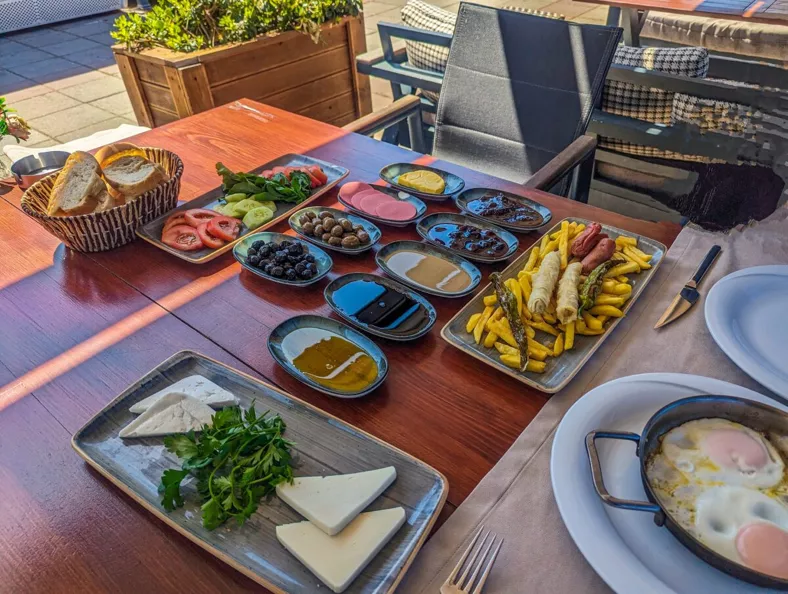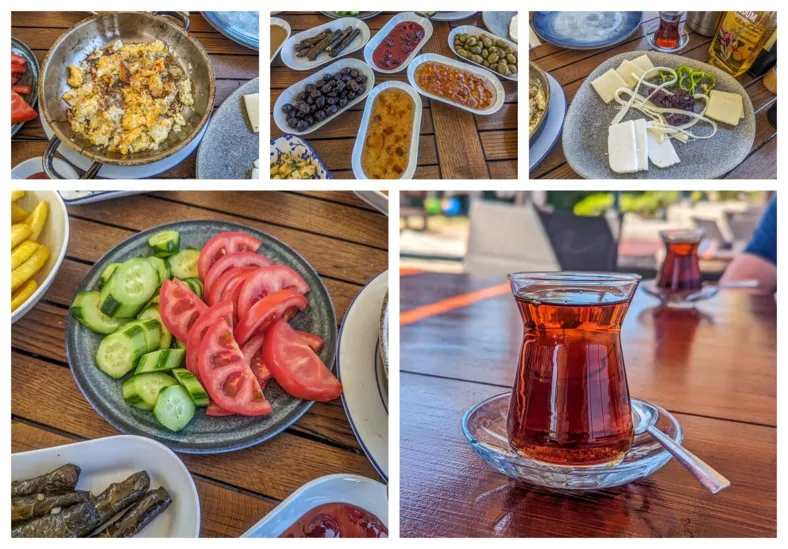No one knows precisely when or why Turkish breakfasts evolved into the grand feasts they are today. In the Middle Ages, breakfast in Türkiye was simple and similar to what was found throughout much of Europe: a modest meal of soup, bread, and cheese.
However, as Türkiye became the heart of the Ottoman Empire, the region’s cuisine began to transform. With the empire’s expansion came wealth, power, and a vast array of cultural influences. The Ottomans adopted and adapted foods from the regions they conquered, integrating new types of cheeses, olives, and spices into their meals. Intricately layered pastries were developed in the royal kitchens for the sultan, eventually trickling down to the general populace. Even tomatoes, which didn’t enter Turkish cuisine until the 19th century, became a staple.
Gradually, the breakfast table expanded to include a more diverse selection of dishes. What was once a humble morning meal grew into a lavish spread, resembling the grand Turkish breakfasts enjoyed today.

A modern Turkish breakfast: more than just a meal
In contemporary Türkiye, such elaborate breakfasts are not an everyday occurrence. Instead, these sumptuous spreads are often reserved for weekends and special occasions. They are leisurely, social affairs, designed as much for enjoying the company of friends and family as for savoring the food itself.
There isn’t a rigid menu for a Turkish breakfast; however, certain dishes are almost always present:
Bread: Various types, including simit — a sesame-covered circular bread similar to a soft pretzel — and pide, a type of flatbread.
Cheese: A variety of cheeses such as beyaz peynir (white cheese), kaşar (a semi-hard yellow cheese), and tulum (a tangy goat cheese).
Vegetables: Sliced tomatoes and cucumbers.
Olives: Both black and green, often marinated with herbs and spices.
Eggs: Served in multiple ways — fried, hard-boiled, or as menemen, a dish of scrambled eggs cooked with garlic, tomatoes, and peppers.
Meat: Spicy sausage known as sucuk or pastırma, a type of cured beef.
Spreads: A range of spreads including honey, butter, preserves, and olive oil.
Turkish Tea: Known as çay, always served in small, tulip-shaped glasses.

Additionally, optional but popular items often enhance the breakfast table:
Potatoes: Often served as French fries or diced and pan-fried.
Clotted Cream: Known as kaymak, typically served with honey.
Stuffed Grape Leaves: Called sarma.
Pastries: Such as börek (a savory pastry stuffed with vegetables, meat, or cheese) and gözleme (a crepe-like pastry filled with various ingredients).
Pancakes: A more recent addition.


Global recognition and popularity boom
Modern tourism in Türkiye began to flourish in the 1950s, with wealthy Europeans and Americans exploring the country’s rich history, culture, and, of course, its cuisine. Word of Türkiye’s extravagant breakfasts soon spread beyond its borders, and local businesses began to promote Turkish breakfasts to curious tourists.
Today, Turkish breakfast has become a must-try experience for visitors to Türkiye. With its delightful variety and emphasis on community and leisure, this meal is more than just food — it’s a reflection of Turkish culture, hospitality, and a history that continues to influence and inspire palates around the world.
Source: Original aricle written by Michael Jensen forGayCities. Photography by Michael Jensen.








